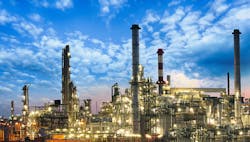Oil and gas extraction can be dangerous work. Between 2015 and 2017, there were 161 fatalities and hundreds more incidents reported, according to data from the National Institute for Occupational Safety and Health.
In an industry with so many different types of equipment and activities that pose a high risk to worker safety, identifying all potential hazards is critical.
And conveying how to mitigate those risks to your crews is equally important. Here’s how oil and gas supervisors can understand their risk landscape and build a communication strategy to keep workers safe.
Overlooked Oil and Gas Safety Hazards: Be Aware of Your Surroundings
Flammable chemicals and powerful machinery aren’t the only culprits of many injuries and fatalities in the oil and gas industry.
Safety supervisors must be well versed not only in the safety protocols of the project they’re overseeing but in the conditions surrounding the job site as well. Crews and job sites are constantly in flux, which means any given project owner may be supervising a new environment on a daily or weekly basis.
Supervisors must be vigilant about the following oil and gas hazards that don’t pertain solely to extraction activities.
1. Vehicle Collisions
The biggest safety risk to oil and gas workers isn’t actually on-site. The Occupational Safety and Health Administration (OSHA) reports that roughly four out of every 10 fatalities in this industry are the result of highway vehicle incidents, making them the leading cause of death.
Project workers and equipment must be transferred to and from well sites, which are often located in remote and distant areas. Collisions can happen when drivers are fatigued or incorrectly operate the transportation vehicle.
Supervisors should ensure that transportation to and around job sites is accounted for when developing safety protocols.
2. Simultaneous Operations
The next leading cause of fatalities in the oil and gas industry is known as struck-by / caught-in / caught-in between accidents, which are responsible for three out of every five on-site fatalities. These incidents typically involve moving vehicles or equipment, falling equipment and high-pressure lines.
Simultaneous operations are often the cause of these hazards.
On an oil and gas well, there may be limited space with multiple subcontractors and different companies working alongside each other. One supervisor may be a water specialist while a neighboring supervisor is a chemicals specialist, and neither knows much about the other’s risk landscape. A worker unaware of the simultaneous operation may accidentally get struck by or caught between equipment.
Whenever you are in close proximity to another project, communicate your own risks to other supervisors and stay in close contact as your own risks evolve.
3. Short-Service Employees
Employees who are contracted on a temporary or short-term basis also pose a great risk to themselves and others on a job site.
The presence of short-service employees is another key risk factor for struck-by / caught-in / caught-in between incidents. Some services don’t require prior experience but involve a fair amount of labor-intensive, high-exposure activities that can be dangerous to new employees if they aren’t properly trained and supervised.
A general rule for supervisors is to limit the ratio of short-service employees to experienced workers to about one to five to make it easier to supervise them while managing other responsibilities.
Create a Culture of Transparency with Crews and Third-Party Supervisors
Honesty is the best policy when communicating oil and gas hazards. Don’t penalize anyone who approaches you with a question.
As personnel, locations and projects change, safety managers must be upfront and proactive in communicating risks in real time. Every project should have at least one champion to communicate changing safety risks both internally and externally.
It’s important to establish a close relationship with neighboring project supervisors in addition to your own project owners. Even if you have an experienced crew on your own project, they may not be familiar with the safety hazards of the crews operating alongside them.
One helpful strategy to promote transparency and education is to create a “pause button” for project operations. If anyone has an important safety question, whether it’s from a short-service employee or a supervisor on a different project, you should be able to halt what your crew is doing to explain the issue effectively.
Take the Double Communication Approach: Relay All Hazards Verbally and Digitally
Thorough communication with project stakeholders isn’t just important in preventing accidents. It’s also crucial for compliance with OSHA standards.
Verbal communication should be the primary means of on-site job safety, but every update should also come in writing.
While paper documentation can support supervisors’ communications for compliance purposes, digital tools can help disseminate information in real time. If there’s a question that can’t be immediately answered by the on-site team, for instance, an app can allow that team to consult the home office for insights.
Digital documentation also helps ensure all critical safety materials, such as a Job Safety Analysis (JSA), are stored and shared with project management teams. Supervisors can also share digital materials with other project supervisors for easy reference when devising their own safety strategy.
Oil and Gas Safety Hinges on Strong Communication
Oil and gas fatalities have begun to fall in recent years. In 2019, there were a reported 25 deaths, down from 69 in 2017.
And that’s hopefully thanks to better communication within and between site crews.
Oil and gas extraction sites are transient in nature. To account for constant changes in surrounding environments, safety supervisors must work together and communicate safety information early and often.
Deren Boyd is a senior vice president of new markets at KPA, an environment, health and safety (EHS) and workforce compliance software and services provider for midsize businesses. KPA solutions help clients identify, remedy and prevent workplace safety and compliance problems across their entire enterprise.
